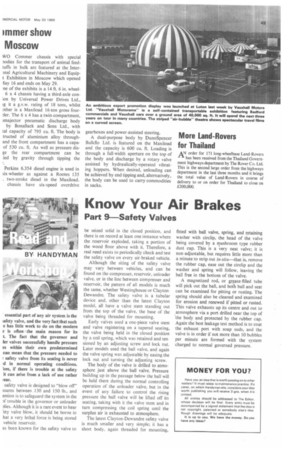Know Your Air Brakes
Page 51

If you've noticed an error in this article please click here to report it so we can fix it.
Part 9—Safety Valves
be seized solid in the closed position, and there is on record at least one instance where the reservoir exploded, taking a portion of the wood floor above with it. Therefore, a real need exists to periodically check and test the safety valve on every air-braked vehicle.
Although the siting of the safety valve may vary between vehicles, and can be found on the compresser, reservoir, unloader valve, or in the line between compresser and reservoir, the pattern of all models is much the same, whether Westinghouse or ClaytonDewandre. The safety valve is a tubular device and, other than the latest Clayton model, all have a valve stem standing out from the top of the valve, the base of the valve being threaded for mounting.
Early valves used a one-piece valve stem and valve registering on a tapered seating, the valve being held in the closed position by a coil spring, which was retained and tensioned by an adjusting screw and lock nut. Later models used the ball valve, and again the valve spring was adjustable by easing the lock nut and turning the adjusting screw.
The body of the valve is drilled to atmosphere just above the hall valve. Pressure building up in the passage below the ball will be held there during the normal controlling operation of the unloader valve, but in the event of any failure to control the rising pressure the ball valve will be lifted off its seating. taking with it the valve stem and in turn compressing the coil spring until the surplus air is exhausted to atmosphere.
The latest Clayton-Dewandre safety valve is much smaller and very simple; it has a short body, again threaded for mounting,
fitted with ball valve, spring, and retaining washer with circlip, the head of the valve being covered by a mushroom type rubber dust cap. This is a very neat valve; it is non-adjustable, but requires little more than a minute to strip out in-situ—that is, remove the rubber cap, ease out the circlip and the washer and spring will follow, leaving the ball free in the bottom of the valve.
A magnetized rod, or grease-filled tube will pick out the ball, and both ball and seat can be examined for pitting or rusting. The spring should also be cleaned and examined for erosion and renewed if pitted or rusted. This valve exhausts up its centre and out to 'atmosphere via a port drilled near the top of the body and protected by the rubber cap. Again the best leakage test method is to coat the exhaust port with soap suds, and the valve is in order if not more than 10 bubbles per minute are formed with the system charged to normal governed pressure.




























































































































